In today’s hyper-connected world, the success or failure of a roofing company often hinges on its online visibility. Homeowners and businesses, facing urgent roofing needs or planning long-term projects, overwhelmingly turn to the internet to find reliable local service providers. This digital dependence has elevated Local SEO for roofing companies from a mere marketing tactic to an indispensable business imperative for roofing contractors.
This in-depth guide provides a comprehensive roadmap for roofing companies to conquer local search results. Drawing upon the expertise and strategies outlined in Chapter 5 of Luis Chavez’s book, “From Clicks to Roofing Clients,” we’ll explore the nuances of Local SEO for roofing companies and equip you with the knowledge to establish a dominant online presence in your target market.
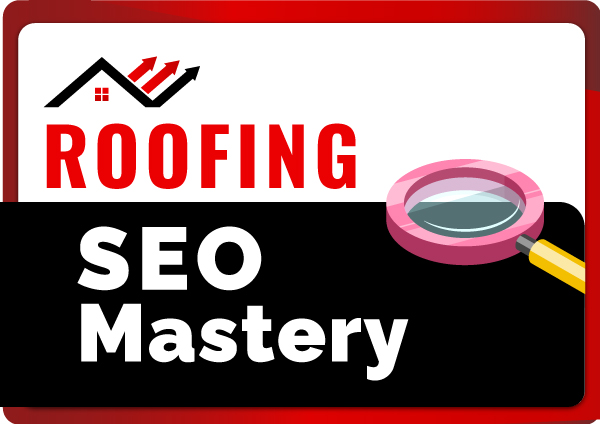
The Evolving Landscape: How Local Search Has Transformed the Roofing Industry
The traditional methods of attracting customers – relying on word-of-mouth, Yellow Pages listings, or even local advertising – are increasingly insufficient. The internet has democratized access to information, empowering consumers to research, compare, and choose businesses based on online factors.
Consider the typical customer journey:
- Awareness of Need: A homeowner notices a leak, a business observes storm damage, or a property manager plans for a roof replacement.
- Initial Research: They turn to a search engine like Google to find local roofing contractors. They might use phrases like: “Emergency roof repair [city]”, “Best roofing companies near me”, or “Commercial roofing contractors [region]”.
- Evaluation: They compare online listings, read reviews, visit websites, and assess credibility.
- Contact and Decision: They contact a few leading contenders and make their choice.
In this journey, Local SEO for roofing companies plays a pivotal role at every stage. It determines which roofing companies appear in the initial search, influences the customer’s perception of their reliability, and ultimately drives the decision-making process.
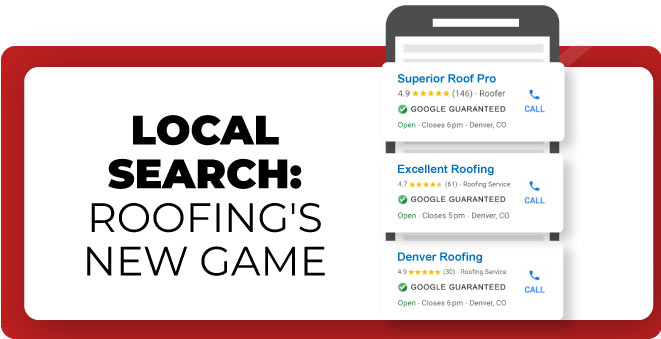
Deciphering the Algorithm: Google’s Local Search Ranking Factors
Google’s local search algorithm is a complex and constantly evolving system. However, its core principles revolve around three primary factors:
Relevance: This is the cornerstone of Local SEO for Roofing Companies.

It’s about how well your business listing and website content match the user’s search query. Google analyzes various factors to determine relevance:
- Keywords: The words and phrases used by searchers (e.g., “shingle roof repair,” “flat roof installation”).
- Business Category: The accuracy and specificity of the categories you select for your Google Business Profile.
- Service Offerings: The clarity and detail with which you describe your roofing services.
- Content: The relevance and comprehensiveness of the content on your website.
Distance: Google prioritizes providing users with the closest and most convenient options.

This factor takes into account the searcher’s location, using various signals such as GPS and IP address, the business address provided in your Google Business Profile, and the geographic area that your company specifies it serves.
Prominence: This encompasses how well-known, respected, and trustworthy your business is, both online and offline.

Online prominence is evaluated by several factors, including the quantity, quality, and recency of reviews across various platforms, the overall strength and trustworthiness of your website (determined by elements like backlinks and content quality), mentions of your business name, address, and phone number on other websites, and your presence and engagement on relevant social media platforms.
Offline prominence includes brand recognition in the community, community involvement and sponsorships, and industry recognition and awards. Understanding these three pillars is fundamental to crafting a successful Local SEO strategy.
Mastering Your Google Business Profile: A Comprehensive Guide
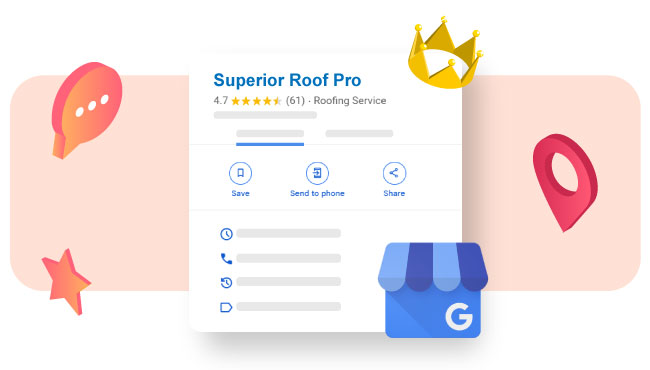
Google Business Profile: Your Digital Identity in Local Search
Your Google Business Profile (GBP) is a free business listing that serves as your primary point of presence on Google Maps and local search results. It’s often the first interaction potential customers have with your roofing company, making its optimization critical for Local SEO for roofing companies.
Claim and Verify Your Profile:
If you haven’t already, it’s essential to claim your Google Business Profile (GBP) listing. This action establishes your ownership and control over the information that is displayed.
Make sure to follow Google’s verification process, which may involve receiving a postcard, phone call, or email. Accurate verification is crucial.
Complete Every Section with Meticulous Detail:
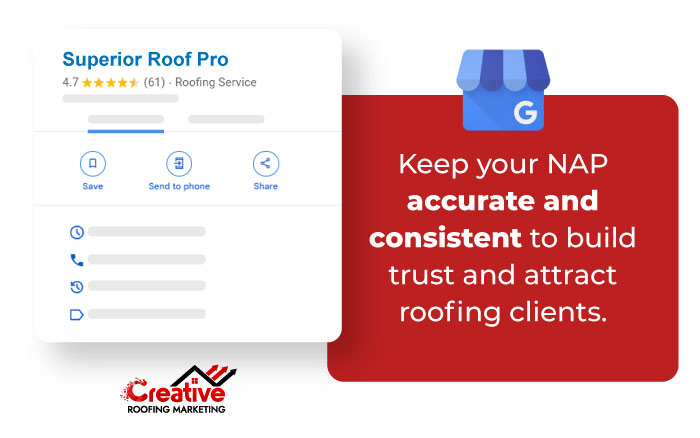
- Business Name:
When entering your Business Name, use the exact legal name as it appears on your official business documents, such as your business license or articles of incorporation. It is critical to avoid adding keywords or location names to your business name, as Google’s guidelines strictly prohibit this, and doing so can lead to penalties.
- Address:
For the Address, provide your accurate and complete physical address, ensuring consistency across your website, online directories, and any other mentions of your business. If you operate from a home office, you have the option to hide your address from public display, but must still specify your service area.
Phone Number:
When listing your Phone Number, use a local phone number if possible. You might also consider call tracking to monitor calls originating from your GBP listing, which can help measure its effectiveness for Local SEO for roofing companies.
- Website:
Include a direct link to your website’s homepage. This is crucial for driving traffic and providing more information to potential customers.
- Categories:
Categories are another key component; select the most relevant primary category that accurately reflects your core business (e.g., “Roofing Contractor”). Add secondary categories to further specify the services you offer (e.g., “Roof Repair,” “Roof Installation,” “Commercial Roofing Contractor”). Remember to be precise and avoid over-categorizing, as this can dilute your profile’s focus.
- Hours of Operation:
Maintain accurate and up-to-date hours of operation. Include regular business hours, as well as any variations for holidays, seasonal changes, or special events.
- Attributes:
Leverage Attributes to highlight specific features and amenities of your business. Relevant attributes for roofing companies might include “Free Estimates,” “Emergency Service,” “Licensed,” “Insured,” “Financing Available,” “Warranty,” and “Locally Owned and Operated”.
- Business Description:
Finally, craft a compelling, informative, and keyword-rich Business Description. Clearly and concisely explain the types of roofing services you provide and emphasize your unique selling proposition (USP) – what sets you apart from competitors. Incorporate relevant keywords naturally and include a clear call to action (e.g., “Contact us today for a free inspection!”). It’s important to avoid promotional language (e.g., “We are the cheapest!”) or special offers in the description.
Visually Captivating Profile with Photos and Videos:

To create a visually captivating profile, it’s essential to incorporate a variety of high-resolution photos on your Google Business Profile. Showcase your business effectively by including exterior and interior photos of your office, if applicable, professional team photos, images of your company vehicles, before-and-after shots of completed roofing projects, and photos displaying the different roofing materials you utilize, as well as images of your team interacting with customers. Ensure all photos are well-lit, in focus, and accurately represent your business’s professionalism.
It is also important to use original images that highlight your actual work, rather than stock photos.
To further enhance your profile, consider using videos, as they are a highly engaging and effective medium for demonstrating your expertise. Utilize videos such as customer testimonials, time-lapse footage of roof installations or repairs, videos explaining different roofing services or materials, and videos that introduce your team and company culture. Remember to keep all videos concise, professional, and informative.
Customer Engagement: Building Relationships and Trust:

- Reviews: To build trust and credibility, actively solicit reviews from satisfied customers. The more positive reviews you have, the more trustworthy your business will appear to potential clients. Make it easy for customers to leave reviews by providing direct links or QR codes. It’s also important to monitor your reviews regularly across all platforms. When responding to reviews, adopt the following approach:
Positive Reviews: Thank the customer for their feedback, express your appreciation, and personalize your responses.
Negative Reviews: Respond promptly and professionally. Acknowledge the customer’s concerns and apologize for any inconvenience they experienced. Offer to resolve the issue offline by providing a phone number or email address. It is crucial to avoid getting into arguments or defensive responses. Instead, use negative reviews as an opportunity to demonstrate your commitment to customer satisfaction and problem-solving.
- Q&A: It’s important to monitor the Questions & Answers section of your Google Business Profile. Provide prompt and helpful answers to customer inquiries. Proactively add frequently asked questions (FAQs) and your answers to address common concerns.
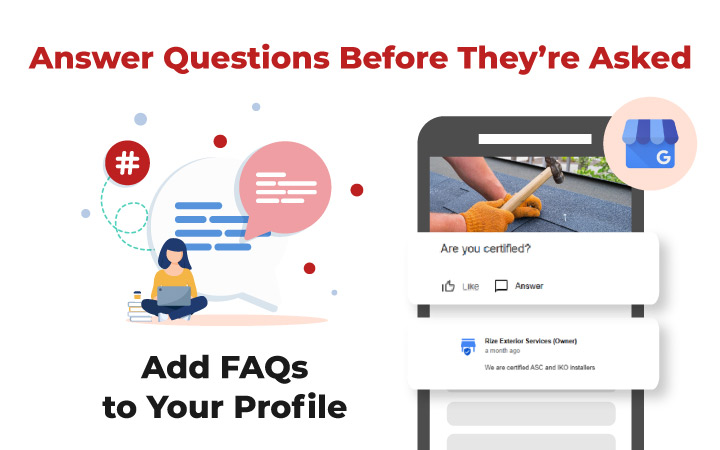
- Messaging: Certainly, enable the messaging feature to allow customers to contact you directly through your profile, and be sure to respond to messages quickly and professionally.
Google Posts: Keeping Your Profile Fresh and Engaging:
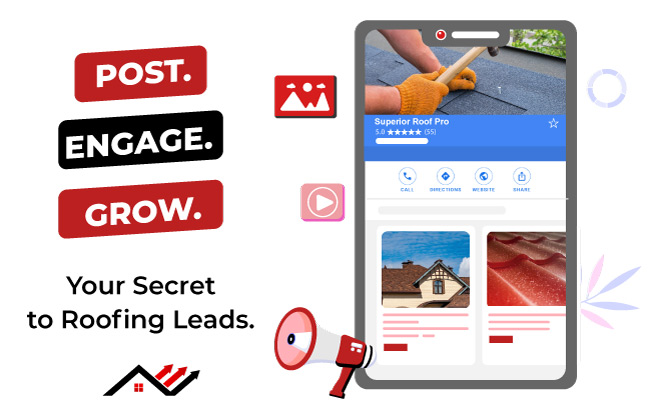
Google Posts are short updates that appear on your Google Business Profile. Use Posts to share announcements about new services or promotions, updates about your business (e.g., new certifications, awards), information about recent projects or completed work, tips and advice related to roofing (e.g., seasonal maintenance), and information about local events or community involvement. Keep your Posts fresh and consistent to maximize visibility and engagement.
Avoiding Google Business Profile Suspensions: Safeguarding Your Local Visibility
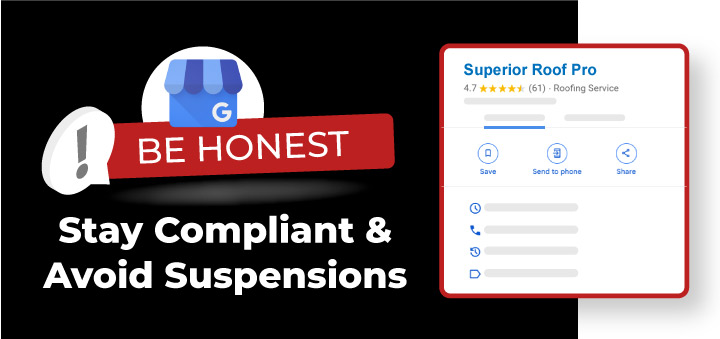
Google has strict guidelines for GMB profiles to ensure accuracy and prevent abuse. Violations can result in suspension, which can severely damage your online visibility. It’s crucial to understand and adhere to these rules:
No Fake Engagement:
- Do not create fake reviews or pay individuals or services to write reviews.
- Do not offer incentives (discounts, gifts, etc.) in exchange for reviews.
- Google’s algorithms are sophisticated and can detect inauthentic activity, leading to penalties.
Accurate Representation:
To maintain the integrity of your online presence, ensure all information in your Google Business Profile accurately reflects your business.
It’s also important to be prepared to provide documentation, such as a business license or insurance, to verify your business information if requested by Google.
Avoid Misinformation:
Provide accurate business hours, contact details, service areas, and any other information, and do not mislead customers with false or inaccurate details.
Prevent Misrepresentation:
- Do not use a P.O. Box or virtual office address as your primary business address.
- Do not use a fake phone number or a number that redirects to another business.
- Do not use images that you don’t have the right to use (e.g., copyrighted images).
- Do not stuff keywords into your business title (e.g., “ABC Roofing Company Best Roofers City”).
Refrain from Inappropriate Content:
Google prohibits content that is hateful, violent, sexually explicit, or misleading.
On-Page Optimization: Optimizing Your Website for Local Search Success

Your website serves as a central hub for your online presence and plays a vital role in Local SEO for roofing companies. It’s where potential customers go to learn more about your services, view your portfolio, and contact you. Optimizing your website for local search is essential to attract nearby customers and convert them into leads.
Key On-Page Optimization Strategies for Roofing Companies
Location Pages: Targeting Specific Service Areas
For businesses targeting specific service areas, creating dedicated web pages for each location is essential.These pages should be highly relevant to local searchers and include targeted keywords, such as “Roof Repair [City Name],” “Roofing Contractor [Neighborhood],” or “Emergency Roofing Services [Region]”.
It’s also important to incorporate unique local content to establish your connection to the area, such as mentioning local landmarks or points of interest, discussing specific weather patterns or roofing challenges common to the area, and including customer testimonials from clients in that location.
Display your consistent business name, address, and phone number (NAP) prominently on these pages and embed a Google Map centered on the location you’re targeting. For example, if you serve both “Anytown” and “Neighborville,” create separate pages for “Roofing Contractors Anytown” and “Roofing Contractors Neighborville,” ensuring each page has unique content tailored to that specific location.
Service Pages: Showcasing Your Expertise

- Optimize your service pages (e.g., “Roof Replacement,” “Roof Repair,” “Commercial Roofing,” “Gutter Installation”) with relevant local keywords.
- Provide detailed descriptions of the services you offer, the types of roofing materials you use, and your service process.
- Incorporate high-quality images and videos of your work.
- Include customer testimonials and case studies to build credibility.
Content Creation: Building Authority and Providing Value

To establish authority and provide value, focus on content creation through a blog and an FAQ section on your website.
Regularly publish informative and engaging blog posts that are relevant to your local audience. Consider these blog post ideas tailored for roofing companies:
Seasonal Content: Craft posts like “Preparing Your [City Name] Home for Winter: Preventing Ice Dams and Snow Damage” or “Protecting Your Roof from the Summer Heat in [Region]”.
Educational Content: Offer valuable information with titles such as “The Top 5 Signs You Need Emergency Roof Repair in [Neighborhood],” “Choosing the Right Roofing Material for [Local Climate Conditions],” or “Understanding Roofing Insurance Claims in [State]: A Step-by-Step Guide”.
Local Focus: Connect with your community through posts like “The History of Roofing Styles in [City Name]” or “Tips for Finding a Reliable Roofing Contractor in [County]”.
FAQ-Style: Address common customer inquiries with posts like “How Much Does a New Roof Cost in [City Name]? Factors to Consider” or “Common Roofing Problems Faced by [Neighborhood] Homeowners”.
Optimize your blog posts for local keywords, answer common customer questions, and provide valuable information to attract and assist your target audience.
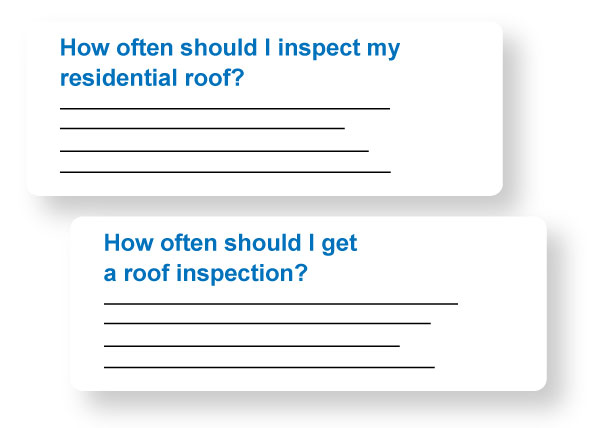
Create a comprehensive FAQ section on your website to address frequently asked questions from potential customers. FAQ topics can include:
Types of roofing materials and their pros and cons
Roofing costs and financing options
The typical timeline for a roof replacement or repair
The process of filing an insurance claim for roof damage
Information about your warranties and guarantees
Local building codes and permit requirements
An FAQ section not only helps customers but also improves your website’s SEO by providing relevant content.
NAP Consistency: Establishing Trust and Accuracy
NAP stands for “Name, Address, and Phone Number.” Ensure that your NAP information is displayed consistently and accurately across your website, Google Business Profile, and all other online directories and citation sources. Inconsistencies in NAP can confuse search engines and negatively impact your local search rankings.
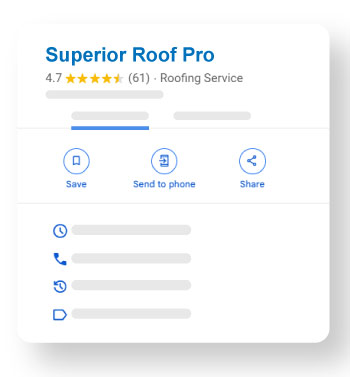
Schema Markup (Structured Data): Helping Search Engines Understand Your Content
To help search engines truly understand your website’s content, consider implementing schema markup, also known as structured data.
This markup provides search engines with a clear understanding of the content on your website. It’s a specific code that tells search engines what type of information is on your pages. For example, this could be details about your business, the services you offer, or reviews.
For roofing companies, relevant schema markup includes LocalBusiness schema, which provides details about your business like your name, address, and hours. Service schema is also relevant, as it specifies the roofing services you offer. And review schema is important for highlighting customer reviews. Implementing schema markup can lead to richer search results and improved visibility.
Mobile Optimization: Catering to the Majority of Users

It’s essential to ensure your website is fully mobile-responsive. This means that your site should adapt seamlessly to different screen sizes and devices, including smartphones and tablets. Mobile optimization is crucial because a significant portion of local searches are conducted on mobile devices. A mobile-friendly website provides a better user experience and is favored by search engines.
Website Speed: Delivering a Fast and Efficient Experience
It’s crucial to optimize your website for fast loading speeds.
Low-loading websites can frustrate users, increase bounce rates (when users leave the site quickly), and negatively impact your search engine rankings. To improve website speed, you should optimize images, minimize code, leverage browser caching, and use a reliable hosting provider.
Building a Stellar Online Reputation: Harnessing the Power of Reviews
Online reviews have become a critical factor in local search. They function as modern-day word-of-mouth marketing, influencing potential customers’ decisions and impacting your search engine rankings. Google considers the quantity, quality, and recency of reviews when determining local search results.
Strategies for Acquiring and Effectively Managing Online Reviews

Provide Exceptional Service: The Foundation of Positive Feedback
The most effective strategy for earning positive reviews is to consistently deliver outstanding customer service. Focus on:
- Clear and prompt communication
- Punctuality and reliability
- Professionalism and expertise
- Attention to detail and quality workmanship
- Respectful and courteous interactions
- Going the extra mile to exceed customer expectations
Ask for Reviews Proactively: Seizing the Opportunity

Don’t hesitate to ask satisfied customers to leave reviews. The optimal time to ask is immediately after completing a successful project, while the customer is still pleased with your service. You can ask for reviews in various ways, including directly requesting a review in person during the final walkthrough, sending a follow-up email thanking the customer and including a link to your review page, sending a polite and concise text message with a review link, or including a request for a review on your invoices or receipts.
Make it Easy for Customers: Streamlining the Review Process
Provide direct links to your review pages on Google, Yelp, Facebook, and other relevant platforms. Consider using QR codes that customers can scan with their smartphones to quickly access review pages. Offer clear and concise instructions on how to leave a review.
Diversify Your Review Sources: A Well-Rounded Reputation

To showcase a well-rounded reputation, encourage reviews on multiple platforms. While Google reviews are highly influential, also seek reviews on Yelp, a popular platform for local business reviews, Facebook, where customers can easily leave reviews on your business page, and industry-specific sites like HomeAdvisor, Angie’s List, or the BBB (Better Business Bureau).
Respond to Reviews: Building Relationships and Addressing Concerns
Responding to Reviews is crucial for building relationships and addressing concerns. When responding to positive reviews, thank the customer for their feedback and express your gratitude. Personalize your responses by mentioning specific details from the review to show that you value customer feedback and appreciate their business.
When responding to negative reviews, respond promptly and professionally. Acknowledge the customer’s concerns and apologize for any inconvenience they experienced. Offer to resolve the issue offline by providing a phone number or email address to contact. It’s important to avoid getting into arguments, making excuses, or becoming defensive.
Instead, use negative reviews as an opportunity to demonstrate your commitment to customer satisfaction, problem-solving skills, and willingness to improve.
Monitor Your Reviews: Staying Informed and Proactive:

Regularly monitor your reviews across all platforms. Track trends in customer feedback to identify areas where your business excels and areas where you can improve, and set up alerts to be notified when new reviews are posted.
Off-Page Optimization: Expanding Your Local Reach Beyond Your Website Walls
Off-page optimization encompasses actions taken outside of your website to influence your local search rankings. It’s about building your online authority and visibility through external signals that validate your business’s legitimacy and relevance.
Key Off-Page SEO Strategies for Roofing Companies
Local Link Building: Acquiring Valuable Connections for Local SEO for Roofing Companies
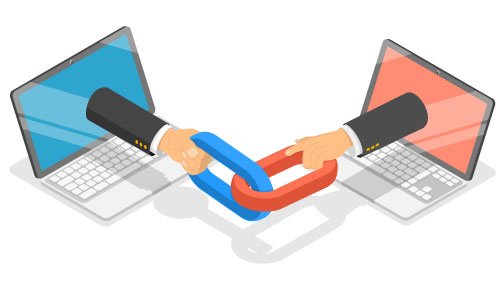
Local link building involves acquiring backlinks, which are links from other websites to your website, from reputable websites within your local area. Local links signal to Google that your business is a trusted and valuable resource in the community.
Local Business Directories:

Listing your business in relevant online directories is an important step. Popular directories include Yelp, Angie’s List, the Better Business Bureau (BBB), HomeAdvisor, MerchantCircle, Local.com, and industry-specific directories such as those for roofing associations. Ensure your NAP information is accurate and consistent across all directories to maximize your Local SEO for roofing companies’ effectiveness.
Chamber of Commerce Membership:
Become a member of your local Chamber of Commerce. Many Chambers of Commerce provide a business directory listing with a link to your website.
Local News Websites:

Seeking opportunities to be featured in local news articles or press releases is beneficial. This could involve sponsoring a local event, participating in a community project, or sharing a press release about a company milestone or achievement.
Sponsorships:
Sponsoring local events, sports teams, or community organizations can be a valuable strategy for Local SEO for roofing companies. Many of these organizations will include a link to your website on their sponsor page.
Partnerships with Complementary Businesses:

Consider partnerships with other local businesses that serve a similar customer base but offer non-competing services. Potential partners for roofing companies include real estate agents, home inspectors, general contractors, HVAC companies, and insurance agents.
Strategies to consider include cross-promoting each other’s services on your websites or social media, exchanging guest blog posts, and participating in joint marketing campaigns.
Online Directories and Citations: Ensuring Accuracy and Consistency
Online directories and citations are important for establishing your online presence and strengthening your Local SEO for roofing companies. Citations are online mentions of your business name, address, and phone number (NAP), even if they don’t include a link to your website.
Citations are important because they help search engines verify your business information and establish your local presence.
Ensure that your NAP information is accurate and consistent across all online directories, citation sources, and your website, as inconsistencies can confuse search engines and negatively impact your rankings.
Social Media: Building Brand Awareness and Engagement

While social media signals may not directly influence local search rankings as strongly as other factors, they can indirectly contribute to your Local SEO success. Social media platforms can help you:
- Increase brand awareness in your local community.
- Drive traffic to your website.
- Foster customer engagement and build relationships.
- Share valuable content related to roofing.
Maintain active profiles on platforms relevant to your target audience (e.g., Facebook, Instagram, etc.) to support your Local SEO for roofing companies efforts.
Monitoring and Analyzing Your Local SEO Performance: A Data-Driven Approach
Local SEO for roofing companies is not a one-time effort; it’s an ongoing process that demands continuous monitoring, analysis, and strategic adjustments. To ensure your efforts are effective, you need to track key metrics and adapt your approach based on the data.
Essential Tools and Metrics for Tracking Local SEO Success
![]()
To effectively track your Local SEO success, several essential tools and metrics can provide valuable insights.
Google Business Profile Insights offers a wealth of data on how customers find and interact with your GBP profile. Key metrics to monitor include Profile Views, which is the number of times your profile is viewed in search results and on Maps.
Search Queries reveal the keywords people use to find your business, helping you understand search behavior and refine your keyword strategy. Customer Actions track actions taken by customers on your profile, such as website clicks, phone calls, direction requests, and messaging.

Google Analytics is crucial for tracking website traffic originating from local searches. Important metrics to monitor here include Organic Traffic, which shows the number of visitors coming to your website from organic search results (excluding paid ads). It’s helpful to segment this traffic to isolate the portion coming specifically from local searches.
Bounce Rate, the percentage of visitors who leave your website after viewing only one page, can indicate whether your website is meeting the needs of local searchers. Time on Site, the average amount of time visitors spend on your website, suggests the engagement and relevance of your content. Finally, Conversion Rate measures the percentage of website visitors who complete a desired action, like filling out a contact form or calling your business. Tracking these metrics is vital for understanding the effectiveness of your Local SEO for roofing companies strategy.
For tracking your rankings for specific local keywords, consider using dedicated SEO ranking tools. These tools can provide valuable insights into your ranking position for target keywords in different locations within your service area, your ranking performance compared to competitors, and changes in your rankings over time.
Content Strategy: The Engine of Your Local SEO Success

Creating valuable and locally relevant content is not just about providing information; it’s a powerful way to attract potential customers, establish your expertise, and significantly improve your search engine rankings.
Content Ideas Tailored for Roofing Companies: A Strategic Approach
Local Blog Posts: Addressing Specific Needs and Interests
These posts are designed to target specific local concerns, events, or interests, driving highly relevant traffic to your website.
- Seasonal Content:
- “Preparing Your [City Name] Home for Winter: A Guide to Preventing Ice Dams and Snow Damage”
- “Protecting Your Roof from the Scorching Summer Heat in [Region]: Essential Tips”
- “The Ultimate Guide to Hail Damage Prevention and Repair for [Neighborhood] Residents”
- Educational Content:
- “The Top 5 Signs You Need Emergency Roof Repair in [Neighborhood] (and What to Do)”
- “Choosing the Right Roofing Material for [Local Climate Conditions]: A Comprehensive Comparison”
- “Understanding Roofing Insurance Claims in [State]: Navigating the Process with Confidence”
- “How to Identify and Prevent Common Roofing Problems in [City Name]”
- Local Focus Content:
- “The History of Roofing Styles and Architecture in [City Name]”
- “A Guide to Local Building Codes and Permits for Roofing Projects in [County]”
- “Meet Our Team: Your Trusted Roofing Experts in [Neighborhood]”
- “Supporting Our Community: [Your Company Name]’s Involvement in Local Events”
- FAQ-Style Content:
- “How Much Does a New Roof Cost in [City Name]? A Breakdown of Factors and Average Prices”
- “What to Expect During a Roof Replacement: A Step-by-Step Guide for [City Name] Homeowners”
- “Financing Your Roof Replacement: Options and Considerations for [Region] Residents”
- “Common Roofing Scams in [City Name] and How to Avoid Them”
- Seasonal Content:
Service Area Pages: Targeting Specific Locations with Precision

Develop dedicated web pages for each city, town, or region you actively serve. Optimize these pages to be highly relevant to searchers in those specific locations. Include targeted keywords, using location-specific keyword phrases like “Emergency Roof Repair [City Name]”, “Commercial Roofing Contractors [Neighborhood]”, and “Roofing Installation Services in [Region]”.
Incorporate unique local content by including references to local landmarks, neighborhoods, or points of interest. Discuss specific weather patterns or roofing challenges that are common in that area, and include customer testimonials from clients in that specific location. Display your consistent business name, address (if applicable), and phone number prominently.

Embed a Google Map centered on the location you’re targeting. For example, if you serve both “Anytown” and “Neighborville,” create separate pages for “Roofing Contractors Anytown” and “Roofing Contractors Neighborville,” with each page having unique content tailored to that location.
Visual Content: Engaging Your Audience and Showcasing Your Work
Visual content is key to engaging your audience and showcasing your work effectively. Before-and-after photos are excellent for visually demonstrating the transformation of your roofing projects. Use high-quality photos that highlight the damage before and the quality of your workmanship after the repairs or installation.
Time-lapse videos can capture the installation or repair process, and these videos can be captivating, showcasing your team’s efficiency and expertise.
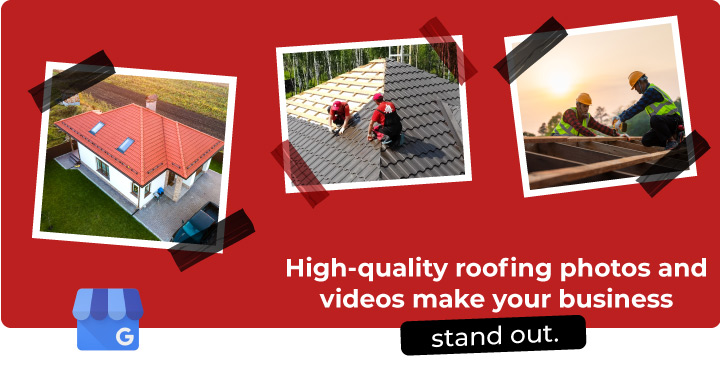
Drone footage provides unique aerial views of completed roofing projects, allowing you to showcase the scope and quality of your work from a different perspective. Team introductions, in the form of short videos featuring your team members and highlighting their experience and qualifications, help personalize your business and build trust with potential customers.
Finally, customer testimonials, especially video testimonials, are particularly powerful for building trust and credibility. Encourage satisfied customers to share their experiences on camera to add a strong layer of social proof to your marketing efforts.
Key Takeaways for Local SEO for Roofing Companies: A Focused and Strategic Approach

To achieve and maintain a strong local online presence and attract a steady stream of local customers, roofing companies must embrace these core principles:
- Prioritize Your Google Business Profile: Your GBP is the foundation of your local online visibility. Invest time and effort in optimizing and maintaining it.
- Maintain NAP Consistency: Accuracy and consistency in your business name, address, and phone number are crucial across all online platforms.
- Target Local Keywords: Optimize your website content and online presence for search queries specific to your service area.
- Build a Robust Review Profile: Actively seek, manage, and respond to online reviews to build trust and credibility.
- Create Valuable and Localized Content: Provide informative, engaging, and locally relevant content that answers customer questions and showcases your expertise.
- Embrace Mobile Optimization: Ensure your website and online presence are fully mobile-friendly to cater to the majority of local searchers.
- Optimize Website Speed: A fast-loading website is essential for user experience and search engine rankings.
- Leverage Local Link Building: Acquire backlinks from reputable local websites to establish your authority and relevance in the community.
- Monitor and Adapt Your Strategy: Track your Local SEO performance using analytics tools and make data-driven adjustments to your approach as needed.
By consistently implementing these strategies and staying informed about the latest Local SEO trends, roofing companies can position themselves for long-term success in the competitive online marketplace.



